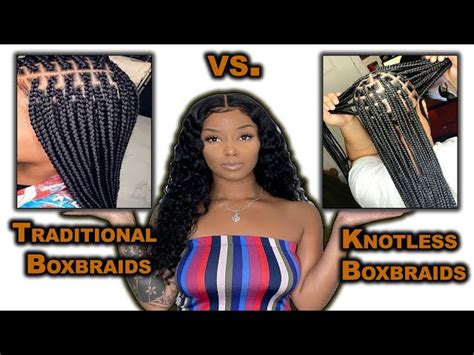The world of protective hairstyles has witnessed a surge in popularity for knotless braids and box braids, each promising unique advantages. While both techniques involve intricate braiding, their inherent differences have sparked a debate among hair enthusiasts. This comprehensive guide delves into the intricate details of knotless braids and box braids, providing an in-depth analysis of their respective characteristics, benefits, and suitability for different hair types.

Knotless Braids: A Scalp-Friendly Haven
Knotless braids, true to their name, eliminate the use of knots in their construction. Instead, they feature a seamless fusion of extensions directly into the natural hair, creating a braid that is both gentle on the scalp and aesthetically pleasing.
Key Characteristics:
- No knots, providing a pain-free braiding experience
- Closely resembles the appearance of natural hair
- Ideal for individuals with sensitive scalps
Benefits:
- Reduced scalp tension and irritation
- Enhanced hair growth due to less pulling on the roots
- Versatile styling options, including buns, ponytails, and braids
Box Braids: A Classic and Timeless Choice
Box braids, a longstanding favorite in the protective styling realm, are characterized by their square-shaped sections. Each braid is meticulously separated and interwoven, resulting in a visually striking and versatile look.
Key Characteristics:
- Knotted construction, creating a secure hold
- Bold, geometric appearance
- Suitable for a wide range of hair types
Benefits:
- Long-lasting and durable
- Protective against hair breakage and damage
- Allows for intricate designs and extensions
Comparing Knotless Braids and Box Braids
To further elucidate the distinctions between knotless braids and box braids, the following table provides a side-by-side comparison of their key features:
| Feature | Knotless Braids | Box Braids |
|---|---|---|
| Knots | Absent | Present |
| Scalp Tension | Low | Moderate |
| Appearance | Natural, seamless | Geometric, bold |
| Longevity | Moderate | High |
| Suitability for Sensitive Scalps | Excellent | Good |
Selecting the Ideal Braiding Technique
The choice between knotless braids and box braids ultimately depends on individual preferences, hair type, and styling goals. Here are some considerations to guide your decision:
Hair Type:
- Knotless braids: Suitable for all hair types, especially those prone to breakage or scalp sensitivity.
- Box braids: Ideal for thick, coarse hair that can withstand the tension of knots.
Styling Goals:
- Knotless braids: Versatile styling options, including sleek buns, voluminous ponytails, and intricate braids.
- Box braids: Striking geometric designs, bold accessories, and the ability to incorporate extensions.
Comfort Level:
- Knotless braids: Provide a more comfortable experience, minimizing scalp irritation and tension.
- Box braids: Can cause some discomfort due to the presence of knots.
Mistakes to Avoid When Braiding
To ensure a successful and satisfying braiding experience, avoid these common pitfalls:
- Over-tightening the braids: This can cause scalp pain and damage to the hair follicles.
- Using extensions that are too heavy or thick: This can add unnecessary weight and strain to the scalp.
- Neglecting scalp care: Regular scalp cleansing and moisturizing are crucial for preventing irritation and maintaining hair health.
- Leaving braids in for extended periods: Beyond the recommended 6-8 weeks, braids can become tangled and damage the hair.
Conclusion
Knotless braids and box braids offer distinct advantages, catering to different hair types and styling preferences. While knotless braids provide a gentle, scalp-friendly option, box braids exude a bold, geometric aesthetic with durable longevity. Understanding the intricacies of each technique empowers individuals to make informed decisions, enhancing their hair care journey and achieving the desired protective hairstyles.
